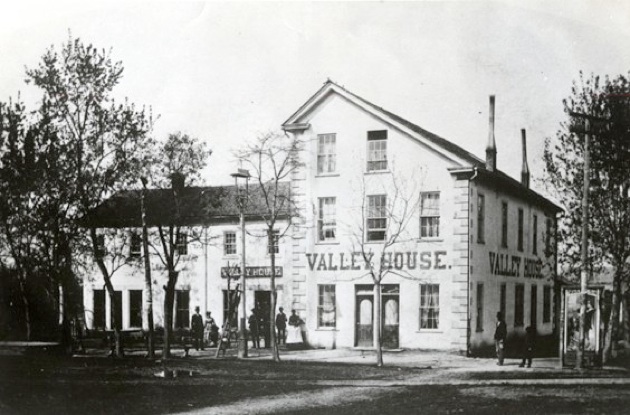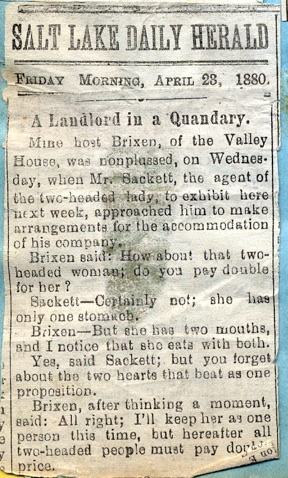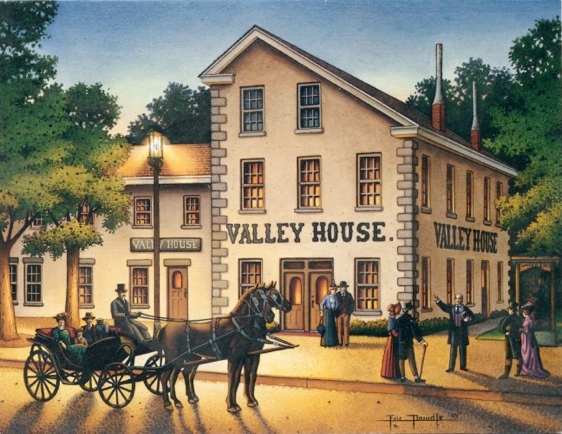The Valley House

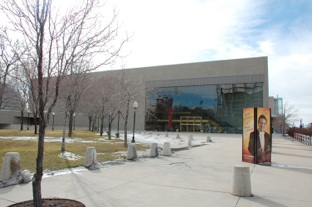
As the area became more commercial, Woodruff moved farther south to pursue his farming. The wing on the right side was added in 1859 when it became a hotel known as the Valley House.
The first two proprietors, George Carter and John Sorenson, were catering to families. The following was taken from their postal cards: "This is the only hotel where no intoxicating liquors have ever been sold on or about the premises. Touch not! Taste not! Handle not the unclean thing!" Elder Sorenson was called on a mission to New Zealand, and the Valley House fell under the "gentile management" of a "live, energetic man who (understood) the secret of successful hotel management, and (paused) not to put his knowledge to advantage.”
On November 1st, 1879, at age 21, Andrew Brixen secured a two-year lease on the Valley House, making him “the youngest landlord in America.” This was made possible in large part by the excellent investments made by his mother.
Shortly after taking over the Valley House, Andrew fell in love with the “beautiful and talented Julia Gutke”, who was working there as a housekeeper. They were married a year later, in 1880, and under their gifted management, the Valley House rose from “an insignificant tavern to one of the best known hotels in the West.” "It was here that he gained his reputation as one of the most beloved and kind-hearted men in Salt Lake City."
The first thing Andrew did after taking over was to renovate and thoroughly repair the house. New furniture, fittings and spring mattresses were installed in each of the 40 apartments allowing a total of 60 guests. The rooms were all re-calcimined and fitted with new carpets and chairs. He engaged Mr. Watts, a first-class cook from Ogden, to look after the cuisine, and he became known for setting a most excellent table. Newspapers as far away as Chicago commented on the "superior character of its table." The large dining room on the north end was refitted to be one of the lightest, airiest and most comfortable in the city. He luxuriantly refurnished the ladies' parlor on the south end of the ground floor to be "a model of elegance and taste."
There were also sitting and waiting rooms and fine facilities for commercial travelers to exhibit their wares and transact their business. Suites were available for families, and a garden that was quite an attraction was planned in the rear where children could amuse themselves. The office
contained a cabinet complete with specimens of the beautiful minerals found in the area and several newspaper clippings of interest.
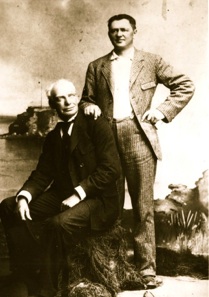
March 27th, 1881, the S. L. Daily Herald talked about improvements made to the Valley House and mentioned, "Particularly noticeable is the placing on the outside of an electric light. It is on the outer edge of the sidewalk, on the east side of the main building, raised on a pole with a
shade over it, and as it is the first of the kind put up in the city, is quite novel, attractive and will be very useful there in the absence of street lamps, as from its height it will throw a bright light over the greater part of the street thereabouts."
Another newspaper clipping claims, ''When the shades of night envelope Zion, the lurid light from the electric current reflects upon the scene, the midnight sun shining with a brilliancy that almost rivals the luminary of day and prolongs the enjoyment of participants."
This Eric Dowdle painting shows Martin and his parents, Julia and Andy Brixen (sporting the red carnation) riding in the carriage. The actor on the right is Andy’s dear friend, WS Sheridan. The cubicle on the right is advertising a local theater production and represents Andy’s love of the theater. This street light is the the first electric street light installed in the area.
Andy kept a scrapbook filled with holiday menus and newspaper articles about the Valley house from cities as far away as Chicago. This one’s about a two-headed lady who came to dine the Valley House and didn’t want to pay for two dinners since she only had one stomach.
